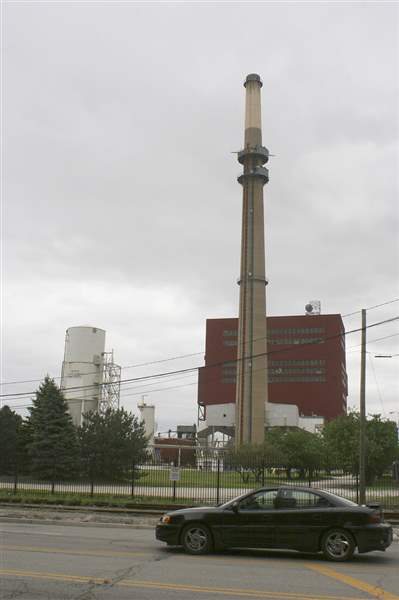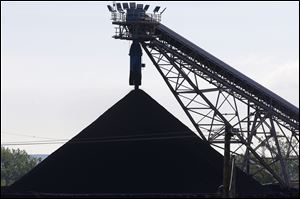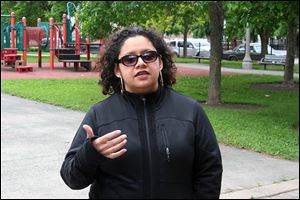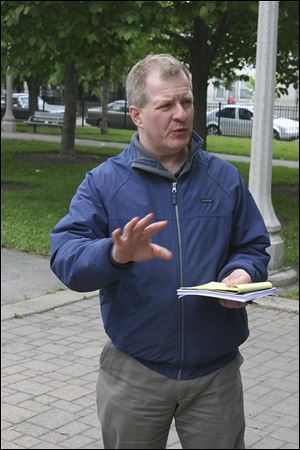
The coal conundrum
5/31/2015
View of the former Fiskar coal-fired power plant along Cermak Road in Chicago. The plant closed after a contentious battle from neighbors and as it became harder to compete with stronger air pollution laws, climate change, falling prices from tracking, etc.
THE BLADE/TOM HENRY
Buy This Image

President Obama’s Clean Power Plan would tighten rules for coal-burning power plants. Chicago’s Fisk power plant, below, and another plant there shut down in 2012 because of health issues tied to emissions and the difficulty such plants face competing financially.
CHICAGO — By using his executive powers to go around a Republican-controlled Congress that won’t pass climate legislation, President Obama is likely to set off a chain reaction in energy markets in June when the U.S. Environmental Protection Agency finalizes his sweeping plan for tighter rules on coal-fired power plants.
Mr. Obama’s Clean Power Plan is one of his administration’s most controversial environmental programs.
Major utilities such as Akron-based FirstEnergy Corp. and coal-rich states such as Ohio are fighting to keep it from getting enacted, while advocacy groups such as the Natural Resources Defense Council and the American Lung Association claim it is essential to improve air quality and set the nation on a path toward meaningful reductions in carbon dioxide and other climate-altering greenhouse gases.
The dynamics go deeper than the far-reaching issue of climate change: The Clean Power Plan is intensifying a national debate over how much newer technology is reasonable before its costs drive monthly electric bills beyond the reach of low-income Americans and those on fixed incomes.
Where’s the sweet spot?
It is a delicate balancing act between the need for blue collar jobs, energy security, and society’s ability to absorb rising costs of treating asthma, chronic obstructive pulmonary disease, and other respiratory conditions.
States will have a year to write their own implementation rules, with the plan scheduled to take effect in 2020.
In Chicago — where the Obamas lived before moving into the White House nearly seven years ago — two shuttered coal-fired power plants stand as monuments to such controversies.
The Fisk coal-fired power plant in southwest Chicago’s Pilsen neighborhood and the Crawford coal-fired power plant in its Little Village neighborhood were shut down in the fall of 2012 because of health issues associated with particles and dust they emitted, as well as the growing difficulty coal-fired power plants now have competing financially.
The modern era of fracking has allowed vast reserves of previously untapped oil and natural gas to be captured. At the same time, more renewable energy projects have been entering the marketplace. Both have combined to turn utilities away from coal, with coal commanding less of the electricity market than it has in decades.
Chicago plants
Both Chicago plants were considered technological marvels in the early 1900s. But their owner, Midwest Generation, a subsidiary of Edison International, shut them down ahead of a negotiated timetable.

View of the former Fiskar coal-fired power plant along Cermak Road in Chicago. The plant closed after a contentious battle from neighbors and as it became harder to compete with stronger air pollution laws, climate change, falling prices from tracking, etc.
“People recognize this was a fundamental justice issue,” said Kimberly Wasserman Nieto, a Little Village resident and neighbor of the Crawford plant who was a 2013 recipient of the Goldman Prize, the planet’s most lucrative for environmental activism. “It was amazing to see after 12 years of struggle.”
Chicago is the only major U.S. city that has had coal plants operating within its borders. In the Toledo area, FirstEnergy also shuttered the three coal units of its Bay Shore power plant in Oregon in 2012. But residents do not live in as close proximity, nor is the Toledo suburb as densely populated.
The National Research Council, after examining 2005 emissions from the Fisk and Crawford coal plants, determined they had hidden health and environmental costs of $127 million a year for the Chicago area.
That report built on one issued in 2002 by the Harvard school of public health. The Chicago-based Environmental Law & Policy Center issued a report in 2010 that estimated $1 billion in hidden health and environmental costs from those two plants over the previous eight years.
Chicago-area health experts joined forces with community activists, but neither had much luck with former Chicago Mayor Richard M. Daley.
“The only thing we ever got from [Mayor Daley’s] office was getting yelled at,” Ms. Nieto said. “No, they never, ever talked to us.”
Current Chicago Mayor Rahm Emanuel — a former member of the Obama Administration — struck a deal to get the plants closed shortly after taking office.
Brian Urbaszewski, a lung specialist for the Respiratory Health Association, a Chicago-based group dedicated to better breathing since its founding in 1906, said health advocates weren’t necessarily trying to get the Fisk and Crawford plants shut down.
They just wanted them modernized.

Kimberly Wasserman Nieto, a Goldman Prize-winning community activist, talks about the fight she and others won against the Fisk coal-fired power plant in Chicago. ‘It was amazing to see after 12 years of struggle,’ she says.
“If I could have gotten them to put on scrubbers, it would have been a victory for me,” Mr. Urbaszewski said. “The reality is there are a lot of plants putting a lot of crap into the air.”
Pollutants waft through miles of air. People in other cities who have more space between them and coal-fired power plants “just don’t see what’s killing them,” he said.
Ally of utilities
Utilities have an ally in Charles Steele, president and chief executive officer of the Atlanta-based Southern Christian Leadership Conference.
The SCLC is a civil rights group best known for being led by the Rev. Martin Luther King, Jr., since its inception in 1957 and until Mr. King’s assassination in 1968.
Mr. Steele said the SCLC recognizes the need to lower coal-fired emissions to address climate change, improve air quality, and reduce health effects of coal-fired power plants, agreeing they often disproportionately impact low-income Americans.
But he said the SCLC is worried too much emphasis is being placed on that and not enough on how tougher standards will drive up monthly electric bills for people who can least afford to spend more.
“Cosmetically, it sounds fine. It sounds good and everyone wants a clean environment. But we can’t do it overnight and not expect poor people to be impacted,” Mr. Steele, 68, said. “It’s the poor that’s going to be affected, the working poor.”
Mr. Steele said the Obama Administration needs to get commitments from other parts of the world before trying to tackle the issue too aggressively at home.
“We have to do it in increments. That’s my point,” he said. “You can’t clean this mess up overnight.”
Industry-generated reports suggest low-income Americans and those on fixed incomes will be hit hard, while major environmental groups such as the Natural Resources Defense Council claim those short-term price increases have been exaggerated.
Environmentalist view
Josh Mogerman, NRDC spokesman, said the nation will be better off in the long term adjusting to a new energy economy.

Brian Urbaszewski, a lung specialist for the Respiratory Health Association in Chicago, says health advocates weren’t necessarily trying to get the Fisk and Crawford plants shut down. They just wanted them modernized.
Tougher rules on coal plants will stimulate more research and development — as well as jobs — in renewable energy, he said.
Though it is unlikely to end the debate, the U.S. Energy Information Administration — a nonpartisan, data-generated branch of the U.S. Department of Energy — said in a May 22 analysis that the Clean Power Plan will likely cause electric rates to increase another 2 to 5 percent more than they would if it is not put into effect.
Rising rates
Jonathan Cogan, EIA spokesman, said it is important to realize electricity costs likely will rise either way. The Clean Power Plan will add to those costs, depending on which version of it is implemented and how energy markets respond, he said.
“A lot of what’s happening in the electricity mix will depend on what’s happening with natural gas,” Mr. Cogan said.
The EIA expects costs associated with the Clean Power Plan to level out and decrease after the initial sticker shock in 2020, when utilities must be in compliance.
Some parts of the country, though — such as the Southeast, the Southern Plains, and the Southwest — could pay as much as 10 percent more if the plan goes through and for a longer time, the report said.
Terry Jarrett, a St. Louis-area lawyer who spent six years on the Missouri Public Service Commission and specialized in critical infrastructure as a member of the National Association of Regulatory Utility Commissioners, said utilities believe the timeline is too aggressive.
More premature closings would come. That would affect national energy security and diversity, he said.
“The experts who operate the electrical systems will tell you it takes a long time to transition,” Mr. Jarrett said. “Given enough time, utilities could adjust to about anything. You just can’t replace [coal] overnight.”
He said he believes the EIA cost analysis is conservative.
Mr. Steele said it’s important to hold the line for low-income Americans and not get caught up in the numbers.
“I’m not in favor of any increase,” Mr. Steele said. “Lord knows we want to clean the environment. What about all of the jobs we’re going to lose? What kind of jobs are we going to replace them with?”
Contact Tom Henry at: thenry@theblade.com, 419-724-6079, or via Twitter @ecowriterohio.